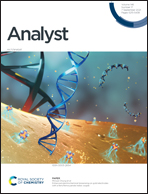Photophysical and NMR studies of encapsulation of 2-cyano-6-hydroxy benzothiazole in p-sulfonatocalix[6]arene and its biological applications†
Abstract
This work deals with the study of the interaction between 2-cyano-6-hydroxy benzothiazole (CHBT) and p-sulfonatocalix[6]arene (SCX6) at different pH values in aqueous medium by UV-visible absorption spectroscopy and steady-state fluorescence spectroscopy. The results demonstrate the strong influence of SCX6 on the fluorescence properties of CHBT. The steady-state emission of CHBT shows strong sensitivity to its environment. The mode of inclusion complexation of CHBT and SCX6 has also been investigated using HR-MS, FT-IR, NMR, 2D NMR, and FESEM analysis. With the increase in SCX6 concentration, absorbance decreased with an isosbestic point at 305 nm. The binding constant is calculated by a spectrofluorimetric method and stoichiometry by Job's method. The formation of an inclusion complex has been confirmed by 2D NMR NOESY, COSY, ROESY, HMBC, and HSQC spectroscopic methods. The complex is seen to be stabilized by electrostatic interactions between CHBT and the nanocavity of SCX6. Studies with cellular systems support that the CHBT–SCX6 complex is more effective in killing cancerous cells and hence, SCX6 may prove to be an effective carrier for drug molecules like CHBT.
![Graphical abstract: Photophysical and NMR studies of encapsulation of 2-cyano-6-hydroxy benzothiazole in p-sulfonatocalix[6]arene and its biological applications](/en/Image/Get?imageInfo.ImageType=GA&imageInfo.ImageIdentifier.ManuscriptID=D1AN00770J&imageInfo.ImageIdentifier.Year=2021)


 Please wait while we load your content...
Please wait while we load your content...